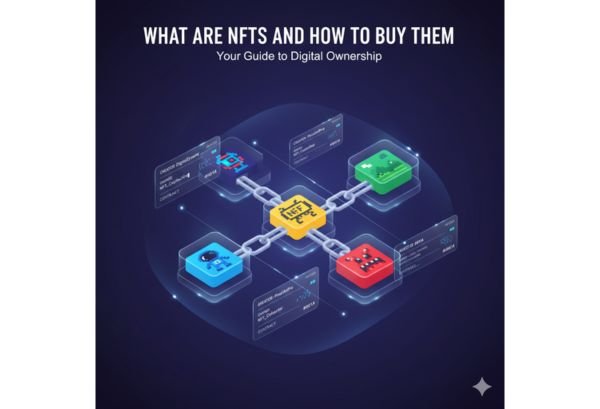Ever come across the term NFT and felt a bit lost? You’re not alone. If you’re asking what are NFTs and how to buy them, this guide is for you. A Non-Fungible Token (NFT) is a unique digital asset representing ownership of an item, such as art, music, or even a virtual collectible. This ownership is securely recorded on a blockchain, making each NFT verifiably authentic and one-of-a-kind.
This guide will demystify the technology, walk you through setting up a wallet, and show you how to navigate the top NFT Marketplaces to make your first purchase with confidence.
Table of Contents
What Are NFTs and How Do They Work?
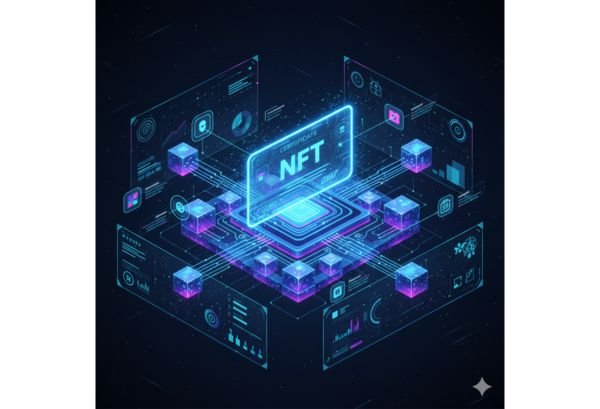
A Non-Fungible Token (NFT) is a unique digital certificate that proves ownership. The “non-fungible” part simply means it’s irreplaceable. For instance, you can trade one dollar bill for another and still have the same value. That’s fungible. But you can’t trade the Mona Lisa for any other painting and have the same thing. That’s non-fungible. NFTs bring this concept of unique ownership to the digital realm.
This is all made possible by blockchain technology. A blockchain is a secure, decentralized digital ledger that records transactions in a way that’s permanent and transparent. When an NFT is created, or “minted,” its details—like its creator, ownership history, and unique ID—are locked onto this public ledger. This creates an unbreakable chain of provenance that anyone can verify. While the Ethereum blockchain pioneered this space, other networks like Solana and Polygon have emerged, offering faster transactions and lower fees.
This verifiable proof of ownership is what gives an NFT its value. While anyone might be able to download a copy of a digital image, only one person can be the verified owner of the official NFT on the blockchain.
What Makes NFTs Valuable?
The price tag on some NFTs can be staggering, but their value comes from a few key sources:
- Authenticity and Scarcity: The blockchain proves an asset is genuine and often part of a limited collection, creating digital scarcity.
- Utility: Many NFTs act as a key, granting holders access to exclusive online communities, real-world events, or special abilities in video games.
- Creator Royalties: A game-changing feature allows artists to earn a percentage of the sale price every time their digital art is resold, providing a sustainable income stream.
A perfect example is the impact on digital art. Artists who once struggled to sell their work can now create verified, single-edition pieces. This shift was famously captured when artist Beeple sold an NFT collage for $69 million at Christie’s, legitimizing a new market for creators and collectors.
Your First Step: Setting Up a Crypto Wallet
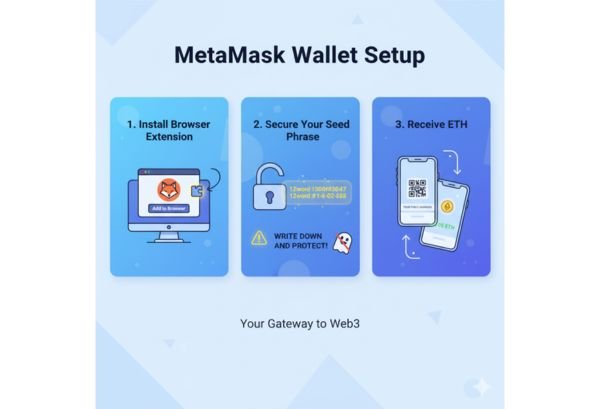
Before you can dive into the world of NFTs, you need a crypto wallet. This isn’t a physical wallet but a software program that stores your cryptocurrency and your digital assets. It’s your personal key to the decentralized web.
For most people figuring out what are NFTs and how to buy them, MetaMask is the industry standard. It’s a user-friendly and widely supported wallet available as both a browser extension and a mobile app, allowing it to connect seamlessly with most NFT Marketplaces.
How to Set Up Your MetaMask Wallet in 4 Easy Steps
- Download and Install: Visit the official MetaMask website (
metamask.io) and download the extension for your browser (like Chrome or Brave) or the mobile app. Always use the official site to avoid phishing scams. - Create Your Wallet: Follow the prompts to “Create a new wallet.” You’ll be asked to create a strong password that protects access to the wallet on your specific device.
- Secure Your Secret Recovery Phrase: This is the most critical step. MetaMask will generate a 12-word “Secret Recovery Phrase.” This phrase is the master key to your wallet and all its assets. If you lose your password or device, this is the only way to recover your funds. Write it down and store it in multiple, secure, offline locations. Never share this phrase with anyone.
- Fund Your Wallet: Once your wallet is created, you need to add cryptocurrency to it. The most common currency for buying NFTs is Ether (ETH). You can purchase ETH on a cryptocurrency exchange like Coinbase or Kraken and then transfer it to your public MetaMask wallet address.
Exploring the Top NFT Marketplaces
NFT Marketplaces are the digital storefronts where you can discover, buy, bid on, and sell NFTs. They are the bustling hubs of the NFT ecosystem. Each marketplace has its own unique community, fee structure, and focus, so your choice will depend on what kind of NFTs you are looking for.
A Deep-Dive into the Leading Platforms
Let’s explore the marketplaces that have become household names in the NFT space.
OpenSea: The Original Behemoth
Often called the “Amazon of NFTs,” OpenSea is the first and largest peer-to-peer marketplace. It boasts an unparalleled collection of assets, from fine digital art and collectibles to virtual land and music.
- Supported Blockchains: Primarily Ethereum, but has expanded to support Solana, Polygon, Avalanche, and more.
- Key Features: A beginner-friendly interface, robust filtering tools, and support for both fixed-price sales and auctions.
- Fees: OpenSea charges a standard 2.5% platform fee on every secondary sale.
My Personal Experience with OpenSea
When I first started my NFT journey, OpenSea was my training ground. Its vastness was both exciting and a bit daunting. I spent hours just browsing different collections before buying my first piece—a simple, generative art NFT. Connecting my MetaMask wallet was seamless, and the “Buy Now” process felt intuitive. The only sticker shock came from the Ethereum gas fees, which were surprisingly high because I happened to be buying during a period of high network traffic. This was a crucial lesson in timing my purchases.
What I Like About OpenSea:
- The sheer volume and variety of NFTs are unmatched.
- Its user-friendly design makes it accessible for newcomers.
- High trading volume means good liquidity for popular collections.
Areas for Improvement:
- The overwhelming selection can make it hard to discover quality projects.
- Ethereum gas fees can make low-priced NFTs prohibitively expensive to buy or sell.
Magic Eden: The Solana Speedster
For those looking to escape high fees, Magic Eden is the premier marketplace on the Solana blockchain. Solana is renowned for its lightning-fast transactions and minimal costs, making it a compelling alternative to Ethereum.
- Supported Blockchains: Primarily Solana.
- Key Features: A launchpad for new projects, a focus on gaming NFTs, and a rewards program for active users.
- Fees: Magic Eden has historically offered very low fees, sometimes even 0% for listing, though its structure can vary. Transaction fees are generally negligible.
My Personal Experience with Magic Eden
My first purchase on Magic Eden was a revelation. I was exploring a new gaming NFT project and decided to buy a few assets. The entire transaction, from clicking “Buy” to seeing the NFT in my wallet, took mere seconds. The fee was less than a cent. This frictionless experience makes Magic Eden an excellent platform for experimenting and collecting more frequently without worrying about high gas fees eroding your budget.
What I Like About Magic Eden:
- Extremely low transaction fees and near-instant speeds.
- A strong, curated launchpad for discovering new Solana projects.
- Vibrant ecosystem for gaming and community-focused NFTs.
Areas for Improvement:
- The NFT selection is not as diverse as on OpenSea.
- The Solana ecosystem, while growing, is less established than Ethereum’s.
Rarible: The Community-Owned Contender
Rarible distinguishes itself with a strong community-first ethos. It operates across multiple blockchains and is governed by holders of its native token, $RARI, who can vote on platform decisions.
- Supported Blockchains: Ethereum, Tezos, Polygon, Solana, and more.
- Key Features: Multi-chain support, decentralized governance via the Rarible DAO, and an aggregator that pulls listings from other marketplaces.
- Fees: Rarible uses a regressive fee structure where the fee percentage decreases as the sale price increases, benefiting high-value transactions.
What I Like About Rarible:
- The multi-chain support provides a broader view of the NFT market in one place.
- Community governance empowers users to have a say in the platform’s future.
- The aggregator feature helps you find the best price for an NFT across different platforms.
Areas for Improvement:
- Its user interface can feel less polished compared to competitors.
- The variable fee structure can be confusing for beginners.
Binance NFT: The Integrated Ecosystem
As an extension of the world’s largest crypto exchange, Binance NFT offers a highly integrated and convenient user experience, especially for existing Binance customers.
- Supported Blockchains: BNB Smart Chain (BSC) and Ethereum.
- Key Features: Very low trading fees, “Mystery Box” drops containing random NFTs, and seamless integration with the entire Binance ecosystem.
- Fees: A flat 1% trading fee, which is among the lowest in the industry.
What I Like About Binance NFT:
- The 1% trading fee is a major advantage.
- The Mystery Boxes are a fun and engaging way to acquire NFTs.
- It’s incredibly convenient for anyone already using the Binance exchange.
Areas for Improvement:
- The platform is more centralized than its peers.
- The majority of collections are on the BNB Chain, which some collectors may find less desirable than Ethereum.
NFT Marketplace Comparison at a Glance
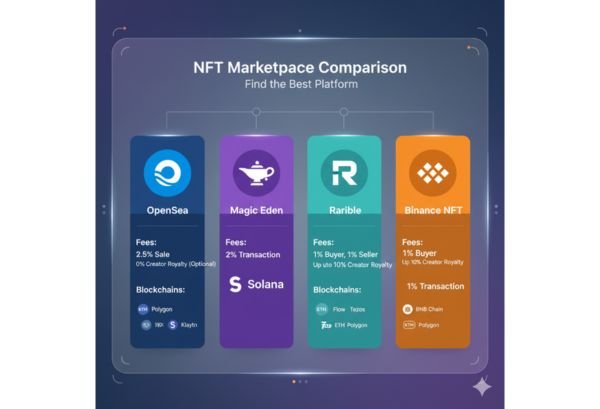
| Feature | OpenSea | Magic Eden | Rarible | Binance NFT |
|---|---|---|---|---|
| Primary Blockchain | Ethereum | Solana | Multi-chain | BNB Chain |
| Trading Fees | 2.5% | Variable (low) | Tiered (0.5%+) | 1% flat |
| Best For | Largest selection | Speed and low fees | Community governance | Binance users |
| Key Advantage | Market dominance | Solana ecosystem | Decentralization | Low trading fee |
The Step-by-Step Guide: How to Buy Your First NFT
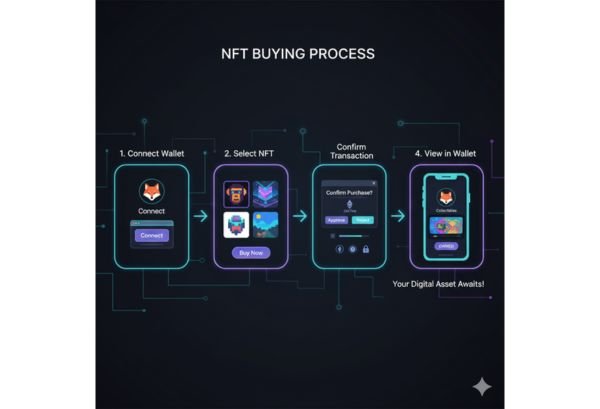
You’ve set up your wallet and chosen a marketplace. Now for the exciting part. Here is exactly how to buy an NFT.
- Connect Your Wallet: Go to your chosen marketplace (e.g., OpenSea) and click the “Connect Wallet” button, usually in the top-right corner. Select MetaMask and approve the connection in the pop-up window.
- Find an NFT: Start exploring. Use the search and filter functions to narrow down your options by collection, price, or specific traits. Research any project that catches your eye. Check its website, X (Twitter) feed, and Discord community to gauge its legitimacy and strength.
- Choose Your Purchase Method: You’ll generally see two options: “Buy Now” for a fixed price or “Make an Offer/Place a Bid” for an auction. A “Buy Now” purchase is immediate. For auctions, you must bid and wait for the auction to conclude.
- Review the Total Cost (Including Gas): Before you finalize the purchase on an Ethereum-based platform, your MetaMask wallet will show you a breakdown of the total cost. This includes the price of the NFT plus the estimated gas fee. Gas fees fluctuate constantly based on network congestion. You can check a site like the Etherscan Gas Tracker to see current rates.
- Confirm the Transaction: If you are comfortable with the total price, click “Confirm” in your wallet. The transaction is then sent to the blockchain for validation. This can take anywhere from a few seconds to several minutes.
- View Your New NFT: Congratulations! Once the transaction is confirmed, the NFT is officially yours. You can view it in the “Profile” or “Collected” section of the marketplace and within the NFT tab of your MetaMask wallet.
If you’re looking for professional web development, SEO services, digital marketing, content marketing, link building, or guest posting, please visit or contact LinkLuminous.com. And if you want to purchase high-quality products online, check out TokyoMart.store for great deals and a wide selection.
Conclusion: Your Journey into Digital Ownership
Understanding what are NFTs and how to buy them is your entry ticket into a transformative digital landscape. While the market is known for its volatility, the underlying blockchain technology is here to stay, fundamentally changing our concepts of ownership, creativity, and community. From digital art and music to gaming and beyond, NFTs are paving the way for the next generation of the internet.
Whether you’re looking to collect, invest, or are simply curious, the golden rule is to do your own research, start with a budget you’re comfortable losing, and engage with the community. By using trusted platforms like OpenSea and securing your assets with a reliable wallet like MetaMask, you can begin to explore this exciting new world with confidence
Here’s a natural, SEO-friendly backlink sentence you can use:
If you want to learn more about NFTs, blockchain trends, and digital assets, you can visit trusted sources like TechBullion.in, MumbaiTimes.net, MindJournal.co, and BangaloreNews.net for in-depth insights and updates.
Would you like me to make it sound more promotional, news-style, or blog-style for better backlink placement?
Frequently Asked Questions (FAQ)
1. Is it possible to lose money on NFTs?
Absolutely. The NFT market is highly speculative and volatile. The value of an NFT can decrease significantly after purchase. Always conduct thorough research and never invest more than you are willing to lose.
2. What are gas fees, and why are they necessary?
Gas fees are transaction costs paid to network validators on a blockchain like Ethereum. This fee compensates them for the computational power needed to verify and add your transaction to the ledger. Fees fluctuate based on network demand.
3. If I buy an NFT, do I own the copyright to the art?
Typically, no. Buying an NFT grants you ownership of the token on the blockchain, which serves as proof you own that specific digital item. However, the creator usually retains the copyright and intellectual property (IP) rights to the underlying artwork unless explicitly transferred in the terms of the sale.
4. What does it mean to “mint” an NFT?
Minting is the act of creating a Non-Fungible Token. It involves publishing your digital file (like a JPEG or MP3) to the blockchain, which tokenizes it and makes it a tradable asset.
5. Are NFTs harmful to the environment?
This has been a significant concern. Early blockchains like Ethereum used a “proof-of-work” system that was energy-intensive. However, Ethereum has since transitioned to a “proof-of-stake” model, reducing its energy consumption by over 99%. Furthermore, many popular blockchains like Solana and Polygon were designed from the ground up to be energy-efficient.
6. What can be an NFT besides digital art?
Virtually any digital or physical item can be represented by an NFT. Popular categories include music tracks, video game items, virtual land in the metaverse, event tickets, exclusive memberships, and even tokenized deeds to real-world assets like real estate.
7. How can I spot and avoid NFT scams?
To stay safe, never share your wallet’s Secret Recovery Phrase. Be skeptical of unsolicited DMs or emails promising free NFTs or access to “secret” mints. Always use official links from a project’s verified social media pages, and remember the old adage: if a deal looks too good to be true, it probably is.
Author Bio:
This article was written by a team of Web3 researchers and content specialists with over five years of combined experience in the blockchain and NFT space. Our expertise comes from actively participating in the market—buying, selling, and analyzing thousands of NFT projects since 2020. Our insights are backed by hands-on experience with platforms like OpenSea, Magic Eden, and Rarible, and a deep technical understanding of blockchain protocols.
References:
- Data on platform fees and supported blockchains are sourced directly from the official websites of OpenSea, Magic Eden, Rarible, and Binance as of Q4 2024.
- Information regarding the Ethereum Merge and its impact on energy consumption is based on reports from the Ethereum Foundation.
- Market statistics and sales data, such as the Beeple sale, are sourced from public records at Christie’s auction house and verified blockchain data.

